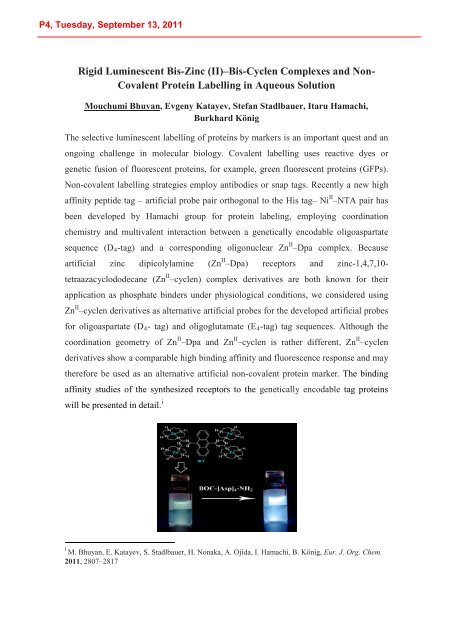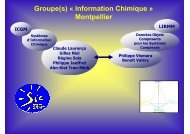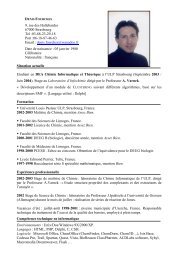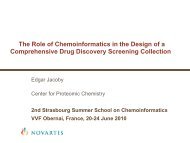International Summer School PROGRAM - Laboratoire d'Infochimie ...
International Summer School PROGRAM - Laboratoire d'Infochimie ...
International Summer School PROGRAM - Laboratoire d'Infochimie ...
Create successful ePaper yourself
Turn your PDF publications into a flip-book with our unique Google optimized e-Paper software.
Rigid Luminescent Bis-Zinc (II)–Bis-Cyclen Complexes and Non-<br />
Covalent Protein Labelling in Aqueous Solution<br />
Mouchumi Bhuyan,<br />
Evgeny Katayev, Stefan Stadlbauer, Itaru Hamachi,<br />
Burkhard König<br />
The selective luminescent labelling of proteins by markers is an important quest and an<br />
ongoing challenge in molecular biology. Covalent labelling uses reactive dyes or<br />
genetic fusion of fluorescent proteins, for example, green fluorescent proteins (GFPs).<br />
Non-covalent labelling strategies employ antibodies or snap tags. Recently a new high<br />
II<br />
affinity peptide tag – artificial probe pair orthogonal to the His tag– Ni –NTA pair has<br />
been developed by Hamachi group for protein labeling, employing coordination<br />
chemistry and multivalent interaction between a genetically encodable oligoaspartate<br />
sequence (D4-tag) and a corresponding oligonuclear Zn II –Dpa complex. Because<br />
artificial zinc dipicolylamine (Zn II –Dpa) receptors and zinc-1,4,7,10-<br />
tetraazacyclododecane (Zn II –cyclen) complex derivatives are both known for their<br />
application as phosphate binders under physiological conditions, we considered using<br />
Zn II –cyclen derivatives as alternative artificial probes for the developed artificial probes<br />
for oligoaspartate (D4- tag) and oligoglutamate (E4-tag) tag sequences. Although the<br />
coordination geometry of Zn II –Dpa and Zn II –cyclen is rather different, Zn II –cyclen<br />
derivatives show a comparable high binding affinity and fluorescence response and may<br />
therefore be used as an alternative artificial non-covalent protein marker. The binding<br />
affinity studies of the synthesized receptors to the genetically encodable tag proteins<br />
will be presented in detail. i<br />
i M. Bhuyan, E. Katayev, S. Stadlbauer, H. Nonaka, A. Ojida, I. Hamachi, B. König, Eur. J. Org. Chem.<br />
2011, 2807–2817









